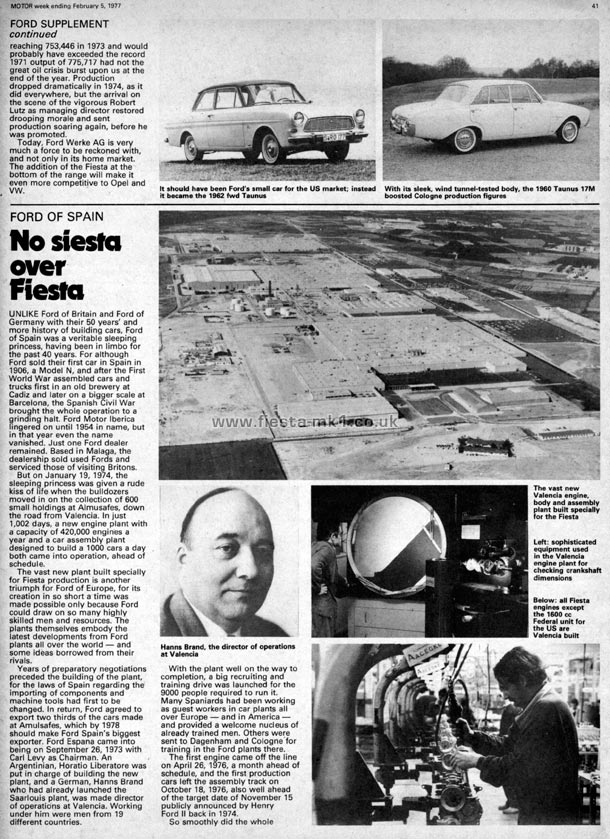Copy of Article Text Below
.....reaching 753,446 in 1973 and would probably have exceeded the record 1971 output of 775,717 had not the great oil crisis burst upon us at the end of the year. Production dropped dramatically in 1974, as it did everywhere, but the arrival on the scene of the vigorous Robert Lutz as managing director restored drooping morale and sent production soaring again, before he was promoted.
Today, Ford Werke AG is very much a force to be reckoned with, and not only in its home market. The addition of the Fiesta at the bottom of the range will make it even more competitive to Opel and VW.
Ford of Spain - No siesta over Fiesta
Unlike Ford of Britain and Ford of Germany with their 50 years' and more history of building cars, Ford of Spain was a veritable sleeping princess, having been in limbo for the past 40 years. For although Ford sold their first car in Spain in 1906, a Model N, and after the First World War assembled cars and trucks first in an old brewery at Cadiz and later on a bigger scale at Barcelona, the Spanish Civil War brought the whole operation to a grinding halt. Ford Motor Iberica lingered on until 1954 in name, but in that year even the name vanished. Just one Ford dealer remained. Based in Malaga, the dealership sold used Fords and serviced those of visiting Britons.
But on January 19, 1974, the sleeping princess was given a rude kiss of life when the bulldozers moved in on the collection of 600 small holdings at Almusafes, down the road from Valencia. In just 1,002 days, a new engine plant with a capacity of 420,000 engines a year and a car assembly plant designed to build a 1000 cars a day both came into operation, ahead of schedule.
The vast new plant built specially for Fiesta production is another triumph for Ford of Europe, for its creation in so short a time was made possible only because Ford could draw on so many highly skilled men and resources. The plants themselves embody the latest developments from Ford plants all over the world - and some ideas borrowed from their rivals.
Years of preparatory negotiations preceded the building of the plant, for the laws of Spain regarding the importing of components and machine tools had first to be changed. In return, Ford agreed to export two thirds of the cars made at Amulsafes, which by 1978 should make Ford Spain's biggest exporter. Ford Espana came into being on September 26, 1973 with Carl Levy as Chairman. An Argentinian, Horatio Liberatore was put in charge of building the new plant, and a German, Hanns Brand who had already launched the Saarlouis plant, was made director of operations at Valencia. Working under him were men from 19 different countries.
With the plant well on the way to completion, a big recruiting and training drive was launched for the 9000 people required to run it. Many Spaniards had been working as guest workers in car plants all over Europe - and in America - and provided a welcome nucleus of already trained men. Others were sent to Dagenham and Cologne for training in the Ford plants there.
The first engine came off the line on April 26, 1976, a month ahead of schedule, and the first production cars left the assembly track on October 18, 1976, also well ahead of the target date of November 15 publicly announced by Henry Ford II back in 1974.
So smoothly did the whole.....
Captions -
Top-Middle - It should have been Ford's small car for the US market; instead it became the 1962 fwd Taunus
Top-Right - With its sleek, wind tunnel-tested body, the 1960 Taunus 17M boosted Cologne production figures
Middle - Hanns Brand, the director of operations at Valencia
Middle-Right - The vast new Valencia engine, body and assembly plant built specially for the Fiesta. Left: sophisticated equipment used in the Valencia engine plant for checking crankshaft dimensions. Below: all Fiesta engines except the 1600 cc Federal unit for the US are Valencia built.
|












